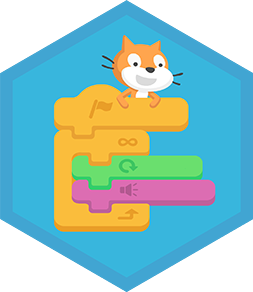Code a Coin Catcher Game in Scratch
Code a Coin Catcher game in Scratch by creating sprites, making falling coins, programming controls, scoring, and sound effects to practice logic and timing.



Step-by-step guide to code a Coin Catcher game in Scratch
How to Make a VERY EASY Catching Game on Scratch!
Step 1
Open Scratch and start a new project so you have a blank stage to build your game.
Step 2
Remove the cat sprite and create or pick a catcher sprite and place it centered near the bottom of the stage.
Step 3
Add code to the catcher so it can move left and right using the arrow keys by making scripts that change x by 10 when the right arrow is pressed and change x by -10 when the left arrow is pressed.
Step 4
Create or choose a round coin sprite and make a bright coin costume so it is easy to see as it falls.
Step 5
Make a variable called Score for all sprites and add a script to set Score to 0 when the green flag is clicked.
Step 6
On the coin sprite add a spawning script: when the green flag clicked hide then forever create clone of myself wait pick random 0.5 to 1.5 seconds.
Step 7
On the coin sprite add a clone script so each clone shows then goes to x pick random -200 to 200 y 180 then repeats moving down by a fall amount until it touches the catcher or goes below the stage then deletes itself.
Step 8
Inside the clone script add a check so if the coin touches the catcher it plays a popping sound changes Score by 1 and then deletes the clone.
Step 9
Create a variable called FallSpeed for all sprites set FallSpeed to 5 when the green flag is clicked and use change y by -FallSpeed in the clone falling loop.
Step 10
Add a tiny script to increase challenge by changing FallSpeed by 1 every time Score reaches 10 so the coins fall faster as you score more.
Step 11
Test your game by clicking the green flag and then tweak the coin spawn wait times sizes and FallSpeed until it feels fun and fair.
Step 12
Share your finished Coin Catcher game on DIY.org so everyone can see how you coded timing logic scoring and sound effects.
Final steps
You're almost there! Complete all the steps, bring your creation to life, post it, and conquer the challenge!


Help!?
What can we use if we don't have a popping sound or a ready-made coin sprite?
Use Scratch's built-in 'pop' sound or record a quick microphone clip for the popping sound and draw a round coin with the Paint Editor to create the bright coin costume described in the instructions.
Why do clones sometimes not appear or the Score not increase, and how do I fix it?
Check that the coin's spawning script hides then forever creates clones, that each clone script starts with 'show' and 'go to x: (pick random -200 to 200) y: 180', that the clone's falling loop uses 'change y by -FallSpeed' and contains 'if touching catcher' to play the popping sound, change Score by 1, and delete the clone, and also confirm you set Score to 0 and FallSpeed to 5 when the green flag is clicked.
How can I adapt this Coin Catcher game for different ages?
For younger kids make the catcher wider and replace the arrow-key scripts with 'go to x: mouse x', increase the coin spawn wait to 1–2 seconds and lower FallSpeed (e.g., 2), while for older kids shorten waits, raise initial FallSpeed, keep arrow-key controls, and add more mechanics like multiple coin types or level logic.
What are simple ways to extend or personalize the game after it's working?
Add different coin costumes with unique point values and sizes, create a 'lives' variable or power-ups that appear as clones, increase FallSpeed by 1 at other Score thresholds besides 10 to make levels, and swap in custom sounds and backgrounds before sharing your finished Coin Catcher on DIY.org.
Watch videos on how to code a Coin Catcher game in Scratch
How to Make a Catch Game in Scratch | Tutorial
Facts about Scratch game programming
⏱️ Practicing timing and controls in games helps improve hand-eye coordination and logical problem-solving.
🎵 Adding short sound effects for catches and misses gives instant feedback and makes play feel more satisfying.
🎮 Coin-collecting is a classic game mechanic used in titles like Super Mario to reward exploration and skill.
🪙 Randomizing where coins fall and slightly changing their speed each round keeps a coin catcher game exciting and unpredictable.
🐱 Scratch's mascot is the Scratch Cat — the block-based interface was made by MIT to help kids create games without typing code.
How do I code a Coin Catcher game in Scratch?
What materials do I need to code a Coin Catcher in Scratch?
What ages is coding a Coin Catcher in Scratch suitable for?
What are the benefits, safety tips, or variations for a Scratch Coin Catcher game?


One subscription, many ways to play and learn.
Only $6.99 after trial. No credit card required


